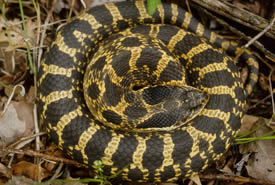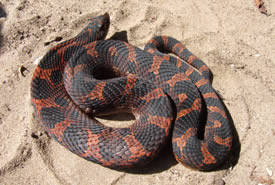Eastern Hog-nosed Snake

Eastern hog-nosed snake (Photo by Mary Gartshore)
What is its life cycle?
In late October, the eastern hog-nosed snake begins hibernation by settling alone in logs or digging deep burrows in sandy soils below the frost line. It re-emerges in early April, when it begins spring mating.
What are the threats to this species?
Eastern hog-nosed snake populations in southern Ontario are being threatened by the loss of sandy woodlands and oak savannahs where they typically live.
What is NCC doing to help protect this species?
The Nature Conservancy of Canada (NCC) is working to conserve important habitat for eastern hog-nosed snakes, from the oak savannah and woodlands of the Port Franks Forested Dunes, Norfolk Forests and Rice Lake Plains, to the acidic rock barrens along Eastern Georgian Bay.
NCC's Ontario Region has also started a school education program that features the eastern hog-nosed snake.
By protecting valuable habitat, educating the public and working with the Species at Risk Recovery Team, NCC will raise the eastern hog-nosed snake's profile and help protect this threatened species.

Eastern hog-nosed snake (Photo by Mary Gartshore)
How can you help protect this species?
Want to help the eastern hog-nosed snake? Report your sighting to the Ontario's Reptile and Amphibian Atlas. Learn more about the eastern hog-nosed snake.
Supported by the Weston Family Foundation.




